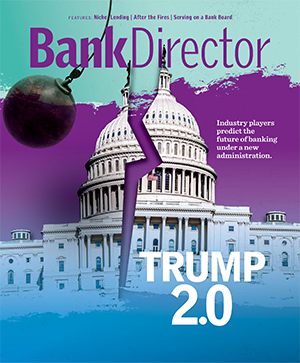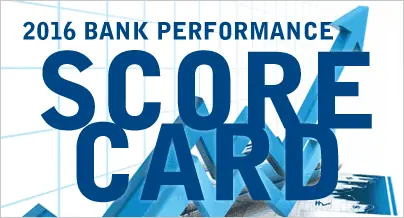
2016 Performance Scorecard
It may be the simplest formula for success in banking: Grow your revenue faster than your expenses. Often referred to as “operating leverage,” this advice falls into the same category as the secret to success in golf, which is to hit the green in two, then one-putt for a birdie. Much easier said than done, in banking as in golf. Indeed, 35 percent of the banks in Bank Director’s 2016 Bank Performance Scorecard, which is a ranking of the 300 largest publicly traded banks and thrifts in the country based on their 2015 results, reported negative operating leverage despite a rise in profitability for the industry overall.
Last year saw a continuation of the challenging operating environment that has largely defined the banking industry in recent years. Competition for loans in a U.S. economy that continues to grow, but not at a pace that is sufficient to stimulate a strong demand for credit, remains intense. Real GDP growth was 2.4 percent in both 2014 and 2015, according to the Bureau of Economic Analysis. Banks that are able to grow loans or increase their fee income while holding the line on expenses-which is proving to be a difficult task-are the most likely to be successful. “I think the magnitude of positive operating leverage that you are able to generate is the real differentiating factor in an environment such as this,” says Scott Siefers, a principal in equity research at Sandler O’Neill + Partners in New York.
The Bank Performance Scorecard is divided into three asset categories, large banks of $50 billion and above, midsized institutions between $5 billion and $50 billion and small banks from $1 billion to $5 billion. The winner of the large bank category was Cincinnati, Ohio-based Fifth Third Bancorp, followed by Capital One Financial Corp. in McLean, Virginia (which won the large bank ranking last year), and Minneapolis-based U.S. Bancorp. In the midsized category, the winner-for the second year running-was Bank of the Ozarks in Little Rock, Arkansas, followed by San Diego-based BofI Holding and Hilltop Holdings in Dallas. The top ranked institution in the small bank category was Anchor BanCorp Wisconsin in Madison, Wisconsin. Anchor was acquired in January by Evansville, Indiana-based Old National Bancorp. Finishing second in the small bank group was German American Bancorp in Jasper, Indiana, followed by NASB Financial in Grandview, Missouri.
After declining 1.1 percent in 2014, the industry’s net income rose 7.5 percent in 2015-to $163.7 billion, according to the Federal Deposit Insurance Corp. The good news is that both net interest income and fee income rose 2.2 percent last year, while noninterest expense dropped 1.3 percent. The bad news is that loan loss provisions rose a whopping 24.1 percent in 2015, according to the agency. This was the first time in six years that the industry had to increase its loss reserves-a sign, perhaps, that the credit cycle has finally begun to turn.
The results of the 300 Scorecard banks were mixed. The median return on average assets (ROAA) for all three size categories declined slightly in 2015. The median return on average equity (ROAE) for the big banks declined 39 basis points despite a corresponding 14 basis point drop in their median tangible common equity (TCE) ratio-which theoretically should have had a positive impact on equity returns because it allowed the group to be slightly more leveraged. (As a general rule, equity returns across the industry have declined in recent years as its capitalization has increased, the result of new capital requirements imposed after the financial crisis.) However, the ROAE for the midsize and small banks showed nice increases in 2015 even as their TCE ratios increased, a testament to their profitability, since they were able to improve their returns despite the higher capital levels. One area where all three size categories showed significant improvement was asset quality. The ratio of nonperforming assets (NPA) to total loans and real estate owned declined for each of the size groupings, with the big banks seeing the sharpest decline, at 56 basis points.
The Scorecard uses five key metrics that measure profitability, capitalization and asset quality. ROAA and ROAE are used to gauge each bank’s profitability. The TCE ratio, a conservative metric that excludes less reliable instruments like preferred stock and debt, is used to measure each bank’s capital strength. And the ratio of nonperforming assets to total loans and other real estate owned, and the ratio of net charge offs to average loans, are used to assess each bank’s asset quality.
The banks received a numerical score in each of the five metrics from highest to lowest. These scores were then added across, and the bank with the lowest total score in each of the asset categories was the winner. For scoring purposes, ROAA, ROAE and the TCE ratio were given full weighting, while the two asset quality metrics were each given a half weighting. Banks that rank high on the Bank Performance Scorecard typically do well in all of the metrics rather than dominate just one or two. The Scorecard rewards banks that are well balanced across the full spectrum of profitability, capitalization and asset quality-but with a slight bias towards profitability.
As in previous years, Sandler O’Neill constructed the rankings using data provided to it by S&P Global Market Intelligence (formerly known as SNL Financial LLC), a financial research firm based in Charlottesville, Virginia.
One of the primary factors in the industry’s performance in 2015 was loan growth, which Siefers says was enough to give it a positive earnings lift. “Loan growth sustained the momentum throughout 2015 [that had begun] the year before,” he says. “The main driver for loan growth tended to be on the commercial side, [beginning with] commercial and industrial [loans], and then commercial real estate began to advance more robustly through the year as well. Sustained low rates and the continually improving housing market has helped mortgage [lending], so that was also very helpful.” Unfortunately, the fierce competition for good loans was also a factor in 2015. The Scorecard banks had an average net interest margin on their loans of 3.5 percent, down slightly from 3.58 percent in 2014.
Asset quality may have reached an “inflection point” last year, according to Siefers. For several years prior to 2015, banks had benefited from a broad improvement in credit trends that allowed them to put less money into their loss reserves. And that, in turn, contributed to their profitability. For many banks, this scenario changed in 2015 as they were forced to start building up their loss reserves again. “The slow and steady normalization of credit trends is beginning to cause [loan loss] provisions to creep up from absolutely low levels,” says Siefers. “I think 2015 was probably the last in about five years of credit costs running as a tailwind. What we are seeing in 2016 and beyond is a turn from tailwind to headwind. We are in the midst of that change right now, and 2015 was likely the last hoorah for credit quality.”
The final variable in the industry’s earnings equation last year was expenses, which declined modestly-although this is not necessarily a trend line that will be pointing down in the years ahead. Traditionally, the cost that banks focused on the most was personnel, since this was the most easy-or at least quickest-to control. But in recent years, the industry’s cost base has been greatly affected by two factors that aren’t likely to abate any time soon. One is the necessity of investing heavily in technologies like mobile, which have become table stakes for any bank that wants to be taken seriously. A second factor is the significant increase in regulatory compliance and legal costs, which are a reflection of the post-crisis environment that banks have been operating in for the last several years. “You have had these newer pressure points over the last couple of years that really feel like they are chronic issues,” Siefers says. “In other words, technology, compliance, legal, regulatory costs, these are now embedded in the fabric of the industry in a way that they have not been in past cycles.”
The winner of the big bank group, Fifth Third, was one of the industry’s top performing banks in the 1990s and early 2000s, then ran into trouble during the financial crisis when it ended up overexposed to the commercial real estate sector. Fifth Third has been investing heavily in new technology and improvements to its risk management capabilities-but still managed to achieve positive operating leverage of 6.3 percent, which is to say that its growth in revenue exceeded its expense growth by that amount. (To read more about Fifth Third President and Chief Executive Officer Greg Carmichael, see page 12.)
The top ranked bank in the midsized category-Bank of the Ozarks-has dominated the Scorecard rankings in recent years. Not only did it win the same category in 2015, but it also placed first in the $1 billion to $5 billion category in 2013 and 2014. Ozarks had positive operating leverage of 14 percent last year, and Chairman and CEO George Gleason said the biggest contributor to the bank’s profitability was its Real Estate Specialties Group, which lends to commercial real estate projects nationwide and has seen exceptional growth in recent years. It is especially impressive that Ozarks posted the third best ROAE in the midsized group, at 15.41 percent, even though it had the fifth highest TCE ratio, at 13.49 percent.
Interestingly, Ozarks’ expenses went up 23.1 percent in 2015, although this was more than offset by a 37.1 percent increase in revenue. Gleason says he expects the bank’s costs to go up every year because when employees do well, they deserve to be compensated for their performance. “The key for us has always been to grow revenue at a faster rate than expenses,” he says.
BofI Holdings, the second place finisher in the midsized category, relies on a digital distribution strategy through its Bank of the Internet subsidiary. The bank saw exceptional growth in C&I loans, single-family mortgages and jumbo mortgage loans over four linked quarters that ran through December 30. (The bank’s fiscal year runs from October 1 to September 30.) Thanks to a digital banking platform that does not rely on a branch distribution system that must employ large numbers of people, BofI has also benefited from a very low cost structure. The bank’s efficiency ratio for the four-quarter period was just 34.5 percent-much better than most traditional banks.
President and CEO Greg Garrabrants says the ratio would have been even lower if the bank wasn’t spending money on a variety of improvements. “We’re investing a whole lot in our risk management infrastructure, and we’re investing a lot in our technology development group,” he says. Garrabrants says that a major initiative over the next five years will be to take more control of the bank’s “software infrastructure” so it can do its own app development. “We’ve vastly increased the amount of IT personnel we have, [along with] development teams, [and hired] lots of folks on the user experience side and made it a strategic long-term goal to really be a great digital bank,” Garrabrants says.
German American Bancorp, which placed second in the $1 billion to $5 billion category, is living proof that well managed banks can thrive, even if they don’t operate in high growth markets like Texas or South Florida. The bank reported record earnings in 2015, driven largely by an 8 percent growth in loans and tight control of expenses. A 4.9 percent growth in revenue, combined with 3.4 percent growth in expenses, gave it positive operating leverage of 1.5 percent. German American operates in 13 southern Indiana counties, and Chairman and CEO Mark Schroeder says that C&I, commercial real estate and agricultural businesses account for about 80 percent of the bank’s total loan portfolio. German American prefers to concentrate on smaller MSA markets where there is less price competition, and in 2015 the bank made a concerted effort to focus even more intently on its best business borrowers. “We said, ‘Hey, let’s get out there and talk to our own customers,’” Schroeder says. “We continue to take market share from our competitors.” Schroeder believes that the bank’s size, at just under $2.4 billion in assets, allows it to occupy a “sweet spot where we can do the deals that small community banks can’t even do, though they’re good at relationship management, too.”
German American also benefited from tight expense control last year. “We’ve been laser focused on the cost side for the last 10 years,” Schroeder says. “The nickels and dimes do matter,” he says. “We’re trying to outrun [margin] compression through the growth in loans and running as lean as we can.” Indeed, growing loans and running lean is a strategy that all banks should be pursuing in the current environment. “For virtually the entire industry, growth is limited,” says Siefers. “There is a lot of capital chasing a limited amount of growth. I think investors perceive costs to be by far the most controllable factor in a management team’s tool kit. Limiting cost growth is a key differentiating factor for banks these days.”
And as strategies go, this one might be easier than hitting the green in two and putting once for a birdie.

Join OUr Community
Bank Director’s annual Bank Services Membership Program combines Bank Director’s extensive online library of director training materials, conferences, our quarterly publication, and access to FinXTech Connect.
Become a Member
Our commitment to those leaders who believe a strong board makes a strong bank never wavers.




